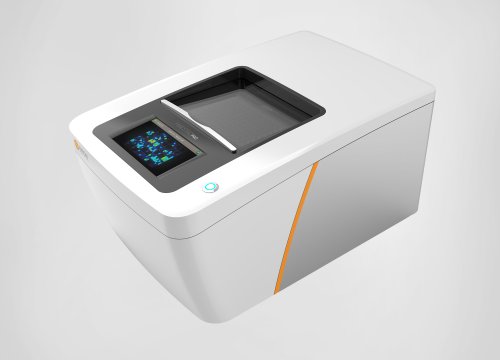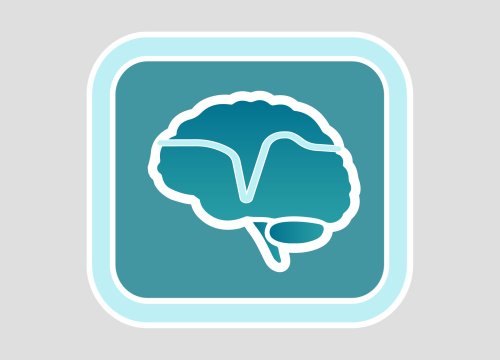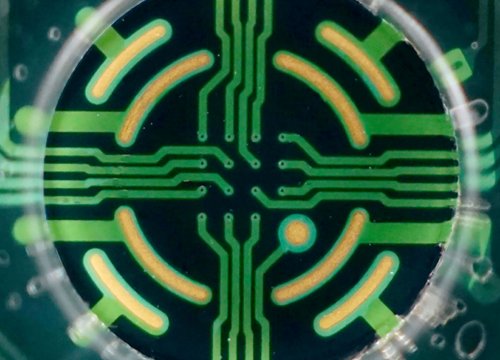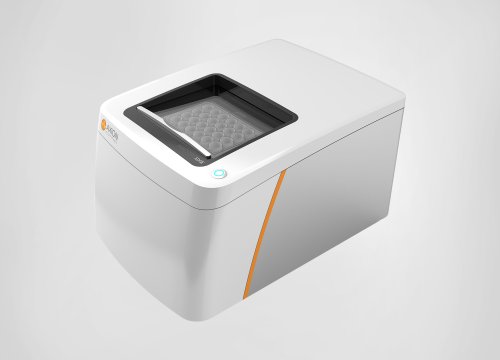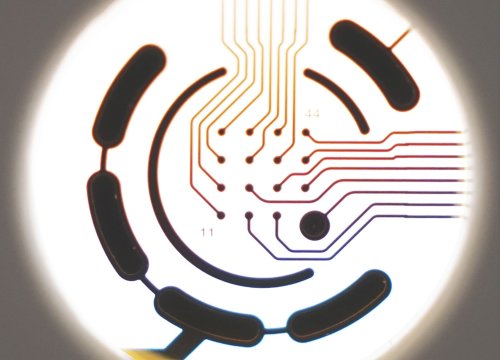In our daily lives we are increasingly continually exposed to man-made chemicals, including pharmaceutical compounds, antimicrobials, flame retardants, food-additives, and pesticides. It is well known that nervous system function is particularly sensitive to disruption by a wide variety of compounds. Consequently, approaches to assess neurotoxicity in a high-throughput screen are required. However, neuroactivity is a complex health endpoint, and existing assays don’t cover the breadth of potential neurotoxicity-related targets. In this webinar, Dr. Marissa Kosnik (Stockholm University) in collaboration with US Environmental Protection Agency, demonstrates how measuring compound-induced changes to the spontaneous firing activity of neural cells in an MEA assay can efficiently screen for diverse chemical activities relevant to neurotoxicity, and that chemical structure may be predictive of response patterns.
Transcript of webinar on Characterizing environmental compounds on the Maestro multiwell MEA system
Thank you for joining for Today’s Coffee Break Webinar. Today’s topic is Characterizing multivariate neuroactivity patterns of environmental compounds
In our daily lives we are continually exposed to man-made chemicals, including pharmaceutical compounds, antimicrobials, flame retardants, food-additives, and pesticides. With the number of chemicals on the market, and volume of chemicals being produced both increasing year-on-year, there is a growing need to understand the potential toxicities associated with these manufactured compounds.
It is well known that nervous system function is particularly sensitive to disruption by a wide variety of compounds. Consequently, approaches to assess neuroactivity in a high-throughput screen are required. However, neuroactivity is a complex health endpoint, and existing assays don’t cover the breadth of potential neurotoxicity-related targets.
In this webinar, Dr. Marissa Kosnik at Stockholm University describes work she did at North Carolina State University in collaboration with the US Environmental Protection Agency, using data generated from networks of neurons grown on multiwell microelectrode array (MEA) plates to develop an efficient approach to screen compounds for neuroactivity.
A previous study had only screened for compound-induced effects at a single concentration on the neural mean firing rate (MFR). Here effects on neural bursting, and connectivity patterns were also tracked across a range of concentrations. These findings demonstrate that this multivariate approach to analysing MEA activity patterns can efficiently screen for diverse chemical activities relevant to neurotoxicity, and that chemical structure may be predictive of response patterns.
Dr. Marissa Kosnik is a postdoctoral researcher in Dr. Oskar Karlsson’s group at SciLifeLab, located at Stockholm University. Her expertise is in computational toxicology with a focus on data integration methods for human and environmental risk assessment. During her PhD at North Carolina state university, she collaborated with the U.S. Environmental Protection Agency to develop microelectrode array data analysis methods for characterizing chemical neuroactivity.
Thank you Melissa for the introduction Today, I will be describing work done in collaboration with Tim Shafer’s group at the U.S. EPA to evaluate neuroactivity of environmental compounds. The ToxCast program evaluates the toxicity of environmental compounds using high-throughput screening.
However, additional methods are necessary to evaluate chemical neuroactivity. One approach is to use microelectrode arrays, or MEAs. What is so powerful about MEAs is that they have been used to assess neuroactivity for a variety of compounds with different modes of action. Further, MEAs can characterize multiple patterns of neuroactivity.
For example, an action potential, or spike, representing general firing activity of a neuron. Bursts of action potentials, and network function across electrodes to measure synaptic connectivity. Therefore, based on the ability of MEAs to detect many activity patterns for a wide variety of compounds, they could be used to screen chemical neuroactivity.
In a previous study, MEAs were used to screen ToxCast compounds. Chemicals were run at a single concentration on rat cortical neurons cultured on MEA 48-well plates and assessed for neuroactivity using the Axion Maestro 1st generation MEA system. In this analysis, only the mean firing rate (MFR), was monitored.
Of the compounds tested, 326 altered mean firing rate and were thus classified as active. However, this analysis was only run at one concentration and measured only one MEA parameter, meaning it did not establish chemical potency nor assess different aspects of network activity. Therefore, in this present study, we used the same study design with 384 of the previously analyzed compounds run in concentration response.
In addition to mean firing rate, 42 other parameters of activity were analysed, including firing, bursting, and connectivity parameters. Baseline activity was determined as 40 minutes before a compound was added and activity was recorded as 40 minutes after. For this study, we had 3 primary objectives.
First, we wanted to establish the potency of these compounds and assess neuroactivity in multiple parameters beyond just mean firing rate. Second, we wanted to determine which of these 43 parameters are most important in differentiating compound neuroactivity. And finally, based on the compounds’ activity behavior, determine if any features of the chemical set could be driving different patterns of neuroactivity.
In order to do this we had several steps in analyzing the data generated from the MEAs. First, we determined compound-parameter activity. This was done using a systematic pipeline to develop concentration-response curves for each of the 384 compounds in each of the 43 parameters, and hits were determined based on a threshold set around baseline activity for each parameter. Through this, we found all 43 parameters were active for at least one compound.
Because 43 parameters are a lot to measure, we were interested in reducing this number. This was achieved through a two part process. First, we clustered all 43 parameters based on how similar the chemical activity patterns were. For example, mean firing rate and weighted mean firing rate clustered together, and thus, by identifying which of these clusters were most closely related, we determine the most redundant parameters And selected the least redundant, in this case mean firing rate. We also kept parameters that had nothing cluster as closely with them, for example number of spikes. Through this method, we reduced the parameter set from 43 down to 27. However, 27 are still a lot of parameters to consider.
For the second step of parameter reduction, we used machine learning. We selected a subset of compounds from our analysis that were known neuroactive or non-neuroactive compounds. Then, based on the potencies of parameters that these compounds were active in. They were ranked based on which were most important in distinguishing between the compounds. Then, with these 27 parameters, we used machine learning to predict whether these compounds were neuroactive from the compound parameter activities.
Based on how many of these compounds were correctly classified we can determine how accurate our model is. In this case, using all 27 parameters correctly classified 96.9% of these compounds. We then began reducing the number of parameters and repeated the process.
From 27 down to 5 parameters. In this way, we were able to identify the subset of parameters that was most essential in distinguishing compound neuroactivity. Thus, based on this analysis 15 parameters resulted in the best classification accuracy. I should also note, to reduce the number of false positives: we imposed that a compound had to be active in at least 3 parameters-this was to account for instances where a compound’s activity just barely exceeded the threshold for a parameter.
Our final dataset had 237 active compounds, 15 parameters that distinguish neuroactivity, and 2060 hits.
Next, we were interested in analyzing the active compounds and their activity patterns. This figure shows the final dataset of compound-parameter associations. The active compounds are the columns and the top parameters we just identified are the rows. Each point is an association whose activity was determined from the concentration-response curves.
As mentioned, there are several different types of neuroactivity that can be assessed through MEA assay parameters, and what was exciting was that through our analysis, we found several different types of activity represented. We found that the top 15 parameters covered different firing, bursting, and connectivity activity measured with MEAs. It is particularly noteworthy that we identified so many connectivity parameters as essential because these tend to be under-represented in chemical neuroactivity analyses in the literature with more emphasis put on firing and bursting. However, these endpoints are emerging as more relevant in characterizing activity, and we independently confirm that here.
That we identified these three different domains of activity through an unbiased approach suggests that consideration of multiple parameters is important in describing how compounds affect neural network activity.
We also found that these compounds represent different bioactivity patterns. Using k-means clustering with these compound-parameter associations, we identified 3 distinct clusters of bioactivity.
- Cluster 1, had compounds that were active in all parameters: firing, bursting, and connectivity.
- In contrast, cluster 2 has a lot of firing activity, less bursting, and few connectivity parameters with the majority covering synchronicity.
- Finally, cluster 3 is characterized by almost a complete lack of firing with burst parameter activity and varied connectivity patterns.
This demonstrates that these methods not only characterize neuroactive compounds, but they can classify distinct neuroactivity patterns as well. While limited by small sets of specific chemical categories in the starting dataset, we also found some segregation of different compound types within these clusters.
We were curious what could be driving these varied neural network activity patterns between the clusters. To determine whether the structure of the chemicals within each cluster was contributing to the bioactivity patterns, we used chemotypes, which are well-defined sub-structural features of chemicals.
One example is shown here for the compound Tetramethrin, with the chemotypes shown to the right. Our goal was to determine whether specific chemotypes were enriched for the chemicals within each cluster. To do that we used the hypergeometric test to determine if the proportion of chemotypes in one cluster was greater than the proportion of chemotypes across all three clusters.
If it was, then that cluster was enriched for those chemotypes. Through this, we found 8 chemotypes enriched for cluster 1 (shown as a bar with darkened color). Cluster 2 had 9 chemotypes enriched, And cluster 3 had 10 chemotypes. Importantly, no single chemotype was enriched in multiple clusters.
Further, we found that certain motifs tended to be enriched within the same cluster. For example, ring structures were more often enriched in cluster 1 and sulfur-containing structures were more enriched in cluster 3. Thus these chemical sub-structural features may be driving the distinct firing, bursting, and connectivity patterns that we found.
There are a lot of directions that we can move forward with this analysis. One example would be to relate the MEA parameters here to the different assays in ToxCast.
It is also possible we could use these parameters to develop adverse outcome pathways for neurotoxicity, which are currently under-developed. Additionally, we could extend our approach to a wider variety of compounds. The starting set analysed here were primarily those active in mean firing rate, but we demonstrated that no single parameter can describe activity for all compounds.
Finally, we could also try this approach with cardiomyocytes. What we have developed here is a basic method for characterizing active compound, so it is possible that we could use this same approach with a broad set of MEA parameters describing cardioactivity.
In conclusion, we developed a robust method to assess chemical neuroactivity across 15 parameters with high accuracy, and these characterized varied firing, bursting, and connectivity patterns. In our dataset, we found that these compounds clustered into three distinct bioactivity patterns, and these were consistent with the underlying structure of the chemicals as determined through the chemotype analysis.
And with that I would like to thank my collaborators on this project, in particular Tim Shafer of the U.S. EPA and David Reif of NCSU. This work was published in Archives of Toxicology at the end of last year and can be downloaded following the DOI shown here.
I would like to welcome anyone with questions either about this project or about our methods in general to email me. Thank you.
And that is the conclusion of today's Coffee Break Webinar. If you have any questions you would like to ask regarding the research presented Or if you are interested in presenting your own research with microelectrode array technology or impedance based assays, please forward them to coffeebreak@axionbio.com. For questions submitted for Dr. Kosnik, she will be in touch with you shortly.
Thank you for joining in on today’s coffee break webinar and we look forward to seeing you again.
